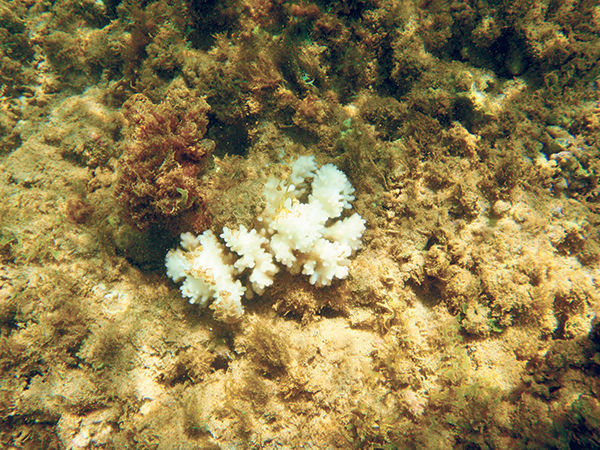KAPAA — Human activities can impact reef health, making it less resilient, according to a recent study conducted by researchers with The Nature Conservancy, and Kauai-based marine biologist Katie Muzik thinks that’s the case on the island. “I would say
KAPAA — Human activities can impact reef health, making it less resilient, according to a recent study conducted by researchers with The Nature Conservancy, and Kauai-based marine biologist Katie Muzik thinks that’s the case on the island.
“I would say the cesspools on Kauai have an impact on the reefs because the hormones and chemicals from them travel into the ocean and affect all the sealife in ways we don’t even know about yet,” Muzik said. “Of course these other factors, like sediment and bleaching, have an effect as well.”
According to the state department of health, cesspools concentrate the wastewater in one location, often deep within the ground and in direct contact with groundwater, causing groundwater contamination.
In previous articles, Janice Okubo, DOH spokeswoman has told The Garden Island the groundwater flows into drinking water wells, streams and the ocean, harming public health and the environment, including beaches and coral reefs.
Currently, the state has a program in place to upgrade cesspool systems to septic systems and there’s a possibility of securing $10,000 in tax credits to do so, if you qualify.
However, Muzik said she thinks the state needs to be looking at different solutions because septic systems aren’t much better than cesspools when it comes to the possibility of water contamination.
Carl Berg, local water expert and coordinator for Surfrider Kauai’s Blue Water Taskforce, in a June 27 TGI article, explained that septic systems “don’t take out anything really except the bacteria.”
“They release nitrogen into the groundwater, and all these pharmaceuticals and personal care products,” Berg told TGI.
Berg and Muzik both urge the state to look at alternative ways of waste management on the island, such as systems that can recycle black water into water clean enough to be used in irrigation.
“We must use the technology available to decrease release of toxic materials from land to sea,” Muzik said.
The Nature Conservancy of Hawaii’s study was conducted in partnership with the National Oceanic and Atmospheric Administration (NOAA) and Marine Applied Research Center.
It looked at the reefs of West Hawaii after a major bleaching event in 2015 caused significant damage. At the sites surveyed, rates of partially or fully bleached coral colonies ranged from 38% to 92%, with more than 90% mortality in some sites.
“Rising sea surface temperatures are a threat to corals globally, but man-made threats are adding more stress to reefs in West Hawaii,” said Eric Conklin, the Conservancy’s director of Marine Science, who presented the study results at last week’s 13th International Coral Reef Symposium.
He added: “To make our reefs more resilient, we need to manage the threats that we can, like reducing fishing pressure on fish that protect reef health by keeping them clean of harmful algae; or reducing runoff of sediments from coastal development and nutrients from outdated wastewater treatment systems.”
The goal of the study was to assess the condition of the reefs and to identify actions that managers and local community members can take to help restore and protect their reefs and nearshore fisheries from further damage. With the planet facing another record hot year, experts say there is considerable urgency to the research.
Researchers sought to assess the condition of the reefs of South Kohala and North Kona, and to identify factors that lead to resilience, or the ability of a reef to recover from extreme events such as coral bleaching.
“Ocean waters are getting hotter and more acidic, and that’s bad news for coral reefs,” said Conklin. “What we have been doing is not sufficient to protect reefs into the future, so the fundamental question is: What can we do to best assure reefs survive in a changing climate?”
Chad Wiggins, the Conservancy’s Hawaii Island marine director, said managers have limited resources to protect reefs and need to make tough choices about where and on what to work. “To do this we need to understand which reefs have the best chance of surviving into the future. This means understanding which reefs are healthiest, as well as which are doing poorly and why,” he said.
To help answer those questions, the Conservancy and its partners conducted detailed surveys along the West Hawaii coastline, with a focus on the reefs of North Kona and South Kohala. The work involved nearly 200 dives at 40 sites from Kawaihae to Keauhou.
Initially, they’ve found major factors that influence coral resilience are the particular species of coral, which reefs have new corals readily settling on available surfaces; and how much of the reef has already been invaded by algae, which compete with coral.
Also evident from the study is that human threats impact reef health. These include overfishing of seaweed-eating fish, sedimentation and nutrient pollution, all of which make reefs less resilient and more susceptible to further damage.
The study, funded by the NOAA Coral Reef Conservation Program, was co-authored by Jeffrey Maynard of the Marine Applied Research Center, and Jonathan Martinez, Danielle Jayewardene, Douglas Harper and Lani Watson, all of the National Oceanic and Atmospheric Administration.
The immediate next step is to present the survey results to government and community partners, so they can begin incorporating resilience into their management actions.


